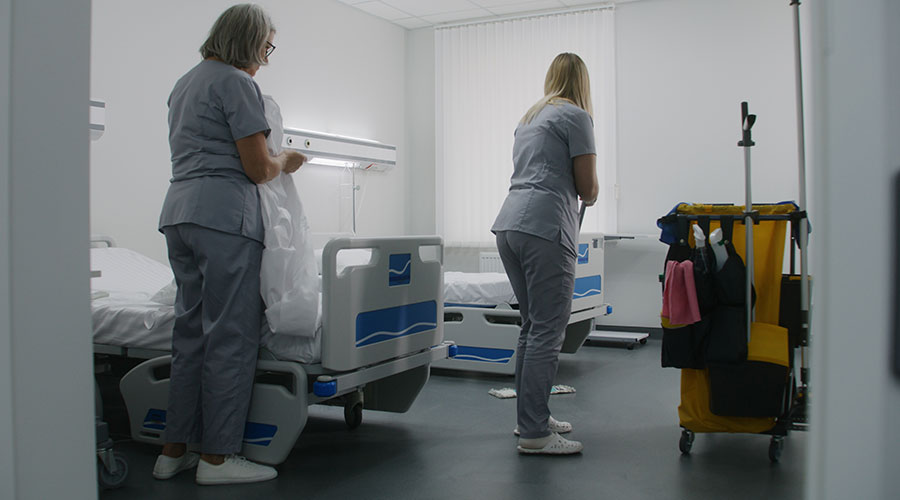Among mission critical facilities, hospitals are the most vulnerable. If they experience an electrical interruption, not just data and revenue are on the line, but people’s lives.
Forty percent of global healthcare organizations have experienced an unplanned outage in the last 12 months — with loss of power being one of the major drivers — at a cost of $432,000 per incident, according to MeriTalk, an online government and healthcare IT community. Emergency power systems are regulated by code to specific standards of performance to prevent life-threatening results. For these reasons, electrical system design is a high priority among healthcare facility engineers.
That said, hospital construction costs are among the highest per square foot and budgets are being squeezed, so designers and engineers are constantly looking for ways to save money without jeopardizing operations.
How can operators be sure they are purchasing and installing the right critical power equipment for their facility’s needs today and in the future?
We believe there are four factors that should be considered prior to designing a hospital’s electrical infrastructure, and specifically, before choosing an uninterruptible power supply (UPS), which conditions incoming utility power and bridges the gap between utility failure and generator start-up.
System performance
An in-depth analysis of the UPS system’s features, topology and power protection performance should be conducted to determine if the equipment meets the specific demands of a facility’s applications.
Some medical imaging equipment, for example, can cause current to spike two to eight times versus the average, so it’s important not only to compare and contrast UPS product spec sheets — which may only cover performance in standard operating modes — but also to investigate in detail their capabilities to handle overloads and steps loads.
Runtime is also important. In recent years, advancements in technology have led to quicker startup times for on-site backup generators. This has been driven by code requirements in the NFPA (National Fire Protection Association) standards and the NEC (National Electrical Code), which require emergency power to be restored within 10 seconds of an outage in a hospital or similar facility.
Despite this, the default within the industry has been to provision UPS with multiple minutes of runtime via batteries. Given the capabilities of today’s generators and code requirements, operators should consider choosing a UPS with less runtime to reduce upfront cost and space requirements.
Reliability
Even during a utility outage, hospitals are expected to remain fully operational, protecting the lives of patients and ensuring availability of their medical records. Electrical disturbances can result in repeated diagnostic tests, wasted medical supplies, expensive service and repair calls, and risks to patient safety. This makes the role and impact of a UPS on hospital electrical system availability even more significant.
But, as some professionals will tell you, reliability is not always viewed by customers as a differentiator when choosing a UPS.
“Some customers’ perceptions are that UPS manufacturers offer similarly reliable products, so they’re more concerned with the total cost of ownership element than reliability,” says Robert Van Wymeersch, general director of Horsepower Europe, a UPS and generator set distributor headquartered in Belgium.
It’s important to keep in mind high reliability is not achieved through a single piece of equipment, but through overall design of the facility’s electrical system. For example, isolation of multiple power paths including capacity components and distribution elements can result in higher overall system reliability. In addition, be clear on UPS manufacturers’ reliability data and studies they may have available.
Maintenance
The IEEE (Institute of Electrical and Electronic Engineers) and most battery manufacturers recommend that batteries be maintained once a quarter and replaced every four to eight years.
While these preventative measures ensure the UPS and batteries are functioning properly, they can directly impact reliability and downtime. Of course, UPS selection will affect maintenance intervals, so keep this mind during the vetting process.
Minimize the probability of human error to help improve reliability and reduce the risk of downtime — as human error is the culprit behind a majority of site failures. For example, the more often your facility changes batteries, the higher the risk that something could go wrong. And when there is a problem, facility managers want to know that it will be resolved quickly.
“Hospital administrators always inquire about response times and the availability of spare parts if there is an equipment malfunction,” adds Van Wymeersch.
Total cost of ownership
While system performance, reliability, footprint, sound restrictions, heating and cooling and maintenance are all important factors to be considered, it ultimately comes down to dollars and cents for most facilities. Doctors may be primarily focused on patients, but the hospital’s finance department is concerned with the health of the balance sheet, so capital and operating expenses need to be carefully calculated and considered.
“The most common questions I am asked are, ‘Is a UPS installation a wise investment?’ and ‘Shouldn’t we be spending this money on other equipment that we use every day?’” says Van Wymeersch. “Grid stability has been negatively impacted with the introduction of renewables and the increase of decentralized power generation in Europe. This has made non-believers who questioned the importance of UPS change their minds.”
Backup power protection will likely become more of a priority for administrators in the U.S., particularly as more hospitals and healthcare facilities begin to explore the possibility of microgrid installations and implementation of renewable energy sources,
Once the decision to install a UPS has been made, different technical and vendor solutions can have a large impact on the bottom line.
Conventional battery-based UPS systems require frequent maintenance and replacement, which can be costly, and are housed in cabinets that take up a great deal of space compared to other hardware, particularly if you specify more than a few minutes of battery runtime. If square footage is a premium in your facility, this may not be the best option.
Temperature should also be considered, as batteries do not fare well in extremely warm environments, so cooling costs should be built into the budget. Batteries operate best in a consistent ambient temperature of 77 degrees Fahrenheit. UPS is not always considered in the original design of a facility, so when retrofitting, many administrators have capital expenditures for additional air conditioning to regulate temperatures and manage heat generated from the UPS equipment.
Another option besides battery-backed UPS is a flywheel UPS, which uses kinetic energy to provide short term power as an alternative to conventional battery energy storage. The flywheel UPS solution asserts a lower total cost of ownership due to higher operating efficiencies, lower maintenance and cooling requirements, and no replacement cost of batteries. However, widespread adoption has been slow due to the shorter runtimes supported (generally less than a minute, depending on load), customers’ lack of experience with the technology and their general apprehension towards change. End users and engineers tend to be risk averse when introducing anything new into a mission critical environment.
Conclusion
Time spent during the planning and design phase to determine which UPS product is best suited for your hospital can directly translate into savings, but more importantly protect the safety of employees and patients. This is time that is very well spent in the long run.
Todd Kiehn is a senior director, product management at Active Power.

 Layered Security on the Rise in Facilities
Layered Security on the Rise in Facilities OhioHealth Plans New Comprehensive Outpatient Cancer Center
OhioHealth Plans New Comprehensive Outpatient Cancer Center Milwaukee Man Imprisoned for Stabbing Hospital Security Guard
Milwaukee Man Imprisoned for Stabbing Hospital Security Guard Disinfectant Dispensers in Healthcare Facilities Often Fail to Deliver Safe Concentrations: Study
Disinfectant Dispensers in Healthcare Facilities Often Fail to Deliver Safe Concentrations: Study Duke University Health System Receives $50 Million for Proton Beam Therapy Center
Duke University Health System Receives $50 Million for Proton Beam Therapy Center